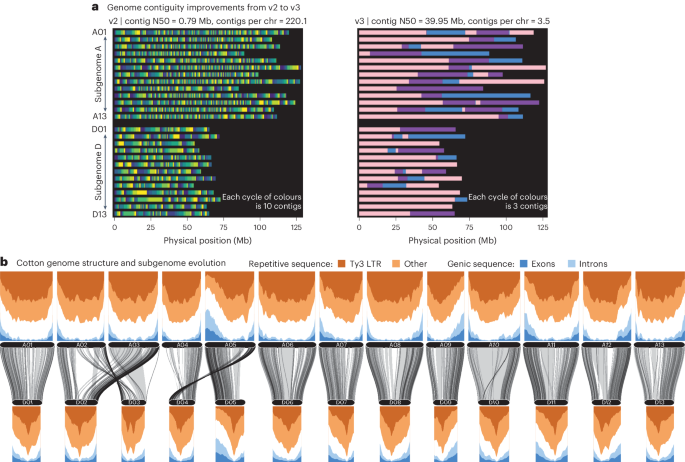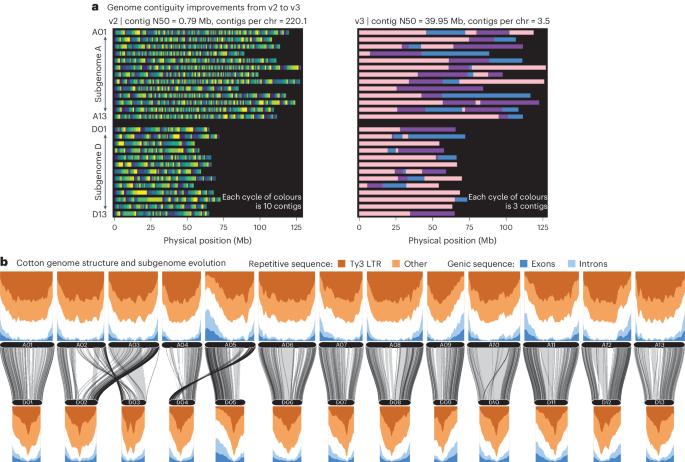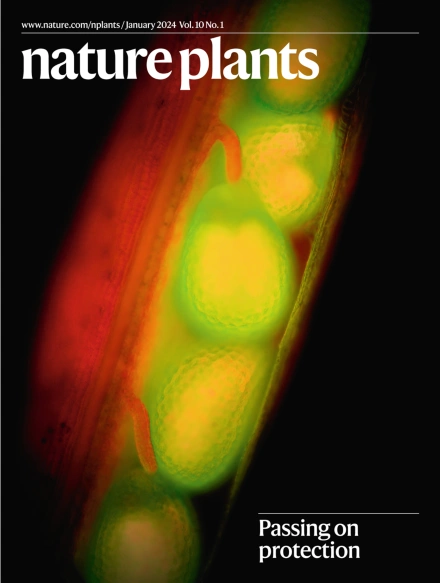三个现代棉花品系的基因组资源指导未来的育种工作
IF 15.8
1区 生物学
Q1 PLANT SCIENCES
引用次数: 0
摘要
棉花(Gossypium hirsutum L.)是世界上主要的可再生纤维作物,但由于基因型特异性以及栽培品种、管理方法和环境因素之间复杂的相互作用,其产量和纤维质量显示出很高的变异性。由于创始基因库狭窄,现代育种方法可能会限制未来的产量提高。精准育种和生物技术方法提供了潜在的解决方案,但这取决于准确的栽培品种特异性数据。在此,我们通过生成三个现代棉花栽培品种('UGA230'、'UA48'和'CSX8308')的高质量参考基因组以及更新'TM-1'棉花遗传标准参考基因组来满足这一需求。尽管假定基因具有一致性,但在四个基因组之间还是观察到了相当大的序列和结构差异,这些差异与'Pima'棉花古老的和正在进行的基因组导入、基因调控机制和表型性状差异相重叠。在纤维发育过程中表达不同的基因与纤维产量相关,这可能是现代棉花栽培品种中观察到的独特纤维质量性状的原因。这些基因组和比较分析为未来提高全球棉花产量和可持续性的遗传努力奠定了宝贵的基础。本文章由计算机程序翻译,如有差异,请以英文原文为准。


Genome resources for three modern cotton lines guide future breeding efforts
Cotton (Gossypium hirsutum L.) is the key renewable fibre crop worldwide, yet its yield and fibre quality show high variability due to genotype-specific traits and complex interactions among cultivars, management practices and environmental factors. Modern breeding practices may limit future yield gains due to a narrow founding gene pool. Precision breeding and biotechnological approaches offer potential solutions, contingent on accurate cultivar-specific data. Here we address this need by generating high-quality reference genomes for three modern cotton cultivars (‘UGA230’, ‘UA48’ and ‘CSX8308’) and updating the ‘TM-1’ cotton genetic standard reference. Despite hypothesized genetic uniformity, considerable sequence and structural variation was observed among the four genomes, which overlap with ancient and ongoing genomic introgressions from ‘Pima’ cotton, gene regulatory mechanisms and phenotypic trait divergence. Differentially expressed genes across fibre development correlate with fibre production, potentially contributing to the distinctive fibre quality traits observed in modern cotton cultivars. These genomes and comparative analyses provide a valuable foundation for future genetic endeavours to enhance global cotton yield and sustainability. Analyses of three newly sequenced modern cultivar cotton genomes revealed sequence and structural variation alongside traces of ancient and ongoing introgressions. Moreover, transcriptome analysis pointed at unique fibre quality traits of cultivars.
求助全文
通过发布文献求助,成功后即可免费获取论文全文。
去求助
来源期刊

Nature Plants
PLANT SCIENCES-
CiteScore
25.30
自引率
2.20%
发文量
196
期刊介绍:
Nature Plants is an online-only, monthly journal publishing the best research on plants — from their evolution, development, metabolism and environmental interactions to their societal significance.
 求助内容:
求助内容: 应助结果提醒方式:
应助结果提醒方式:


